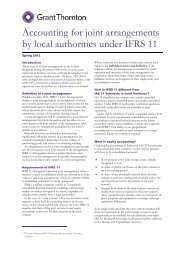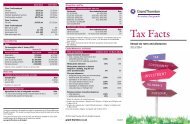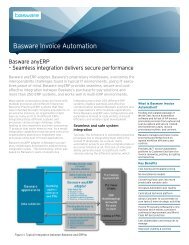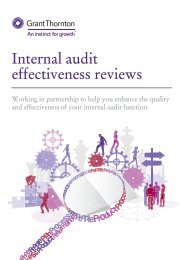Solvency II â State of play - Grant Thornton
Solvency II â State of play - Grant Thornton
Solvency II â State of play - Grant Thornton
- No tags were found...
You also want an ePaper? Increase the reach of your titles
YUMPU automatically turns print PDFs into web optimized ePapers that Google loves.
Contents03 Introduction04 Headline findings05 <strong>State</strong> <strong>of</strong> <strong>play</strong>09 Detailed findings09 Composition <strong>of</strong> respondents11 Preparing for <strong>Solvency</strong> <strong>II</strong>19 Going live21 Concluding remarks22 Contacts2 SOLVENCY <strong>II</strong> – STATE OF PLAY
Introduction<strong>Solvency</strong> <strong>II</strong> has already been dominating theagendas <strong>of</strong> non-life insurers for a number<strong>of</strong> years. And, with the recent delays toimplementation, it looks certain to continueto demand their attention for several more.The preparations for the new regime have required substantialinvestment <strong>of</strong> time, resources and money and there is no endin sight. But what do insurers really think <strong>of</strong> <strong>Solvency</strong> <strong>II</strong>?Will all the effort, the frustrations and the headaches be worthit once the regime is in place? Will the benefits ultimatelyoutweigh the costs and will the end justify the means?In order to discover the answers to these questions, weundertook a survey <strong>of</strong> senior executives in the non-lifeinsurance sector during September and October 2012. Weasked them how prepared they are for the brave new world<strong>of</strong> <strong>Solvency</strong> <strong>II</strong>, what areas they still need to focus on, andhow they view the new regime after so many years <strong>of</strong> effort.Their answers make for fascinating reading.It is more than three years since our last <strong>Solvency</strong> <strong>II</strong>survey. At that time, preparations for the regime werein their infancy and little guidance had been issued. Thecontrast between the responses we received then and now isextremely interesting.We received responses to our latest survey from the UK,Ireland, Continental Europe and Bermuda and from a range<strong>of</strong> different insurance entities. We are enormously gratefulto everyone who took the time to complete the survey – itis self-evident, but nonetheless true, that without you, thisreport would not exist.Regardless <strong>of</strong> whether or not you responded to thesurvey, we hope that you will find the results as interestingand informative as we do.Simon SheafGeneral Insurance Practice LeaderT +44 (0)20 7728 3280M +44 (0)7792 228065E simon.h.sheaf@uk.gt.comSOLVENCY <strong>II</strong> – STATE OF PLAY 3
clearly demonstrate a shift in themarket’s perception since, in 2009, thecorresponding percentages were allzero. The implementation process, theconstant delays, the complexity <strong>of</strong> theregime and the quantity <strong>of</strong> man hoursthat have been expended preparing for<strong>Solvency</strong> <strong>II</strong>, have all resulted in a loss<strong>of</strong> the market’s hearts and minds. Thisshould be <strong>of</strong> concern to regulatorsand supporters <strong>of</strong> <strong>Solvency</strong> <strong>II</strong> whowill need to promote the benefits<strong>of</strong> the new regime effectively andpersuade the market <strong>of</strong> its usefulnessin order to ensure buy-in from seniormanagement.Based on the responses that wereceived, it is evident that insurancecompanies are further behind in thepreparations than their peers in theLloyd’s market. This is not a surprisein the light <strong>of</strong> the Corporation <strong>of</strong>Lloyd’s efforts to drive the syndicatesthrough the process, which includedthe imposition <strong>of</strong> strict deadlines,accompanied by significant guidanceand support. However, although thelevel <strong>of</strong> preparedness is different, it isevident from the responses that bothinsurance companies and Lloyd’smanaging agents have exactly the samepriorities on their agendas for thecoming months and this is in line withour experience <strong>of</strong> talking to people inthe market.An interesting observation is thatone in ten Lloyd’s managing agentsbelieves that the calculation <strong>of</strong> thestandard formula is not relevant forthem, despite the fact that regulatorshave the right to require an insurerto calculate its <strong>Solvency</strong> CapitalRequirement (SCR) on the basis <strong>of</strong>the standard formula even if it is usingan internal model, and therefore theyshould be prepared for that eventuality.Another noteworthy observation isthat although transferring <strong>Solvency</strong><strong>II</strong> from project basis to business asusual is very high in the agendas <strong>of</strong>both Lloyd’s managing agents andinsurance companies, 3% <strong>of</strong> the latterbelieve that this is not relevant forthem. This may be explained by thefact that some insurance companiesare not yet fully aware <strong>of</strong> <strong>Solvency</strong> <strong>II</strong>requirements, since they still need tomake progress in various <strong>Solvency</strong> <strong>II</strong>elements, as illustrated in detail in themain body <strong>of</strong> the survey. This could bea signal to regulators to devote moreattention to small and medium insurersby providing further assistance andsupport to ensure these companies willkeep up with the pace and will be fully<strong>Solvency</strong> <strong>II</strong> compliant on time.In terms <strong>of</strong> the calculation <strong>of</strong> theregulatory capital requirements,Lloyd’s managing agents are obligedby the Corporation <strong>of</strong> Lloyd’s touse an internal model. However,the same is not true for insurancecompanies and when we asked themhow they proposed to calculatetheir requirements, the results wereenlightening and demonstrated ashift in the market position. At thetime <strong>of</strong> our 2009 survey, 34% <strong>of</strong> the6 SOLVENCY <strong>II</strong> – STATE OF PLAY
insurance company participants hadchosen to use an internal model for thecalculation <strong>of</strong> their SCR, 8% a partialinternal model, and none had chosenthe standard formula, while 58%were undecided. These percentageshave changed in 2012 with 39% <strong>of</strong>the insurance company participantschoosing to use an internal model,14% a partial internal model and 47%choosing either the standard formula orthe standard formula with UndertakingSpecific Parameters (USPs). This maysuggest that the vast majority <strong>of</strong> thecompanies that were undecided in2009 ended up selecting the standardformula. An analysis <strong>of</strong> the responsesindicates that many small to mediuminsurance companies have been put<strong>of</strong>f the development <strong>of</strong> an internalmodel by the complicated and timeconsuming internal model approvalprocess, the onerous documentationand validation requirements and theshortage <strong>of</strong> experienced resources. Thisfinding accords with our experience <strong>of</strong>the market.Interestingly, the most significantconstraint identified by participants inimplementing <strong>Solvency</strong> <strong>II</strong> is the lack<strong>of</strong> certainty around the requirements.This implies that, despite thevoluminous information produced byEIOPA and the regulators, <strong>Solvency</strong><strong>II</strong> requirements are still not clear. As aresult, companies are concerned aboutinvesting too much time before thefinal details have been clarified in casesome <strong>of</strong> that time turns out to havebeen wasted in the light <strong>of</strong> informationthat subsequently emerges. This isperhaps understandable given therecent delays and the potential thatthey could lead to previously resolvedSOLVENCY <strong>II</strong> – STATE OF PLAY 7
issues being reopened. Nevertheless,we would caution firms againstdelaying for too long while awaitingfurther clarification. There is still asignificant amount <strong>of</strong> work to do andit is imperative that firms begin totackle it as soon as possible. Althoughsome minor details <strong>of</strong> the new regimeare expected to change between nowand the final implementation date, thestructure as currently envisaged willnot change substantially.Of some concern is that, even atthis stage, 55% <strong>of</strong> respondents cited alack <strong>of</strong> understanding as a constraintand 35% were constrained by a lack <strong>of</strong>board engagement.A further finding is that, althoughthe participants are confident in theirown ability to be fully <strong>Solvency</strong> <strong>II</strong>compliant by 1 January 2014, with81% <strong>of</strong> insurance companies and 94%<strong>of</strong> Lloyd’s managing agents saying thatthey would be, they are less confident<strong>of</strong> their peers’ progress with only37% believing that 70% or more <strong>of</strong>the insurance market will be readyby 1 January 2014, and 25% thinkingthat less than 50% <strong>of</strong> the market willbe ready. This divergence <strong>of</strong> opinioncould indicate either overconfidencein respondents’ own readiness or anunjustified pessimism about that <strong>of</strong>their competitors.A final interesting insight that theresponses revealed is the market’slimited awareness about IFRS 4 Phase2. Since IFRS 4 Phase 2 is going tochange the way insurers are accountingfor their insurance contracts, it willhave a material impact on insurers’reporting structure. Despite this,more than a third <strong>of</strong> the market hasnot considered it at all. Although itis understandable that participantsare currently focusing on <strong>Solvency</strong><strong>II</strong>, it is important that insurers donot underestimate the challenges andthe complexity IFRS 4 will bring andensure they leave sufficient time andresources for them to be addressed.This issue is exacerbated by thefact that IFRS 4 will, like <strong>Solvency</strong><strong>II</strong>, require substantial changes toIT systems. In our view it will besignificantly more efficient to buildthe requirements <strong>of</strong> both regimes intoa single project rather than runningseparate sequential projects.8 SOLVENCY <strong>II</strong> – STATE OF PLAY
Detailed findingsComposition <strong>of</strong> respondentsType <strong>of</strong> companiesOur survey was focused on the nonlifeinsurance sector. Of those whocompleted the survey, 50% werefrom insurance companies (includingcomposites and reinsurers) whilst 45%were Lloyd’s managing agents (Fig. 1).Role within organisationThe survey was sent to a wide selection<strong>of</strong> senior executives in the insurancesector. Responses were received fromindividuals in a variety <strong>of</strong> roles.More than a third <strong>of</strong> the returnedsurveys (39%) were completedby executives in risk managementdepartments, while 23% were returnedby actuaries (Fig. 2). 11% <strong>of</strong> theresponses came from finance directorsand 7% came from personnel whowere dedicated to implementingand complying with the <strong>Solvency</strong> <strong>II</strong>directive (ie <strong>Solvency</strong> <strong>II</strong> project teams).2% <strong>of</strong> the responses came from CEOs,while the remaining 18% were returnedby executives in a variety <strong>of</strong> differentfunctions including compliance, claimsand internal audit.Fig 1: Type <strong>of</strong> companyLloyd’s managing agency 45%Insurance company 50%Other 5%Fig 2: What is your role within your organisation?CEO 2%FD 11%Actuary 23%Risk 39%<strong>Solvency</strong> <strong>II</strong> 7%Other 18%SOLVENCY <strong>II</strong> – STATE OF PLAY 9
Annual premium incomeAnnual premium income <strong>of</strong> thecompanies that participated in thesurvey ranged from less than £20mto more than £1bn. We have split theparticipants into three groups; smallfirms (less than £100m), medium firms(between £100m and £500m) and largefirms (more than £500m). On this basis11% <strong>of</strong> the participants came fromsmall firms, 43% medium firms and46% large firms (Fig. 3).A closer look at the responsesreveals that 67% <strong>of</strong> the small firmsare insurance companies and 33% areLloyd’s managing agents (Fig. 3). Thecomposition <strong>of</strong> the medium firms isdifferent, with 42% being insurancecompanies and 58% being Lloyd’smanaging agents. As for the large firms,53% <strong>of</strong> them are insurance companiesand 47% Lloyd’s managing agents.Fig 3: Annual Premium IncomeSmall 11%Medium 43%Large 46%Insurance company 67%Lloyds 33%Insurance company 42%Lloyds 58%Insurance company 53%Lloyds 47%Gross technical provisionsThe gross technical provisions <strong>of</strong> thecompanies that participated in thesurvey ranged from less than £50mto more than £3bn. We have split theparticipants into three groups; smallfirms (less than £250m), medium firms(between £250m and £1bn) and largefirms (more than £1bn). On this basis,33% <strong>of</strong> the participants came fromsmall firms, 28% medium firms and39% large firms (Fig. 4).56% <strong>of</strong> the small firms areinsurance companies and 44% areLloyd’s managing agents (Fig. 4). Thecomposition <strong>of</strong> the medium firms isdifferent, with 29% being insurancecompanies and 71% Lloyd’s managingagents. As for the large firms, 67% areinsurance companies and 33% Lloyd’smanaging agents.Fig 4: Gross Technical ProvisionsSmall 33%Medium 28%Large 39%Insurance company 56%Lloyds 44%Insurance company 29%Lloyds 71%Insurance company 67%Lloyds 33%10 SOLVENCY <strong>II</strong> – STATE OF PLAY
Preparing for <strong>Solvency</strong> <strong>II</strong>Fig 5a: Overall, what is your impression <strong>of</strong> <strong>Solvency</strong> <strong>II</strong>?Clearly the most appropriateway to run our businessgoing forwardA necessary evil24%27%30%52%A box ticking exercise4%21%2009More red tape from Brussels7%28%20120% 10% 20% 30% 40% 50% 60%Impressions <strong>of</strong> <strong>Solvency</strong> <strong>II</strong>Generally speaking, the insuranceindustry does not appear to accept theneed for <strong>Solvency</strong> <strong>II</strong>, with only 24%agreeing that the <strong>Solvency</strong> <strong>II</strong> regimeis ‘clearly the most appropriate wayto run our business going forward’(Fig. 5a). Interestingly, the insuranceindustry appears to have becomemore doubtful about <strong>Solvency</strong> <strong>II</strong>over the past three years. This can bedemonstrated by the fact that in 2009,over half <strong>of</strong> all respondents agreedthat <strong>Solvency</strong> <strong>II</strong> regime was ‘clearlythe most appropriate way to run ourbusiness going forward’.27% <strong>of</strong> the respondents believedthat ‘<strong>Solvency</strong> <strong>II</strong> is a necessary evil’;a similar percentage (30%) expressedthis opinion in our 2009 survey. Aninteresting observation is that thepercentage <strong>of</strong> respondents that chosethe remaining options has increasedsignificantly. 21% believe that <strong>Solvency</strong><strong>II</strong> is ‘a box ticking exercise’ (thecorresponding percentage in 2009 wasonly 4%) and 28% believe that it is‘more red tape from Brussels’ (in 2009only 7% believed this was the case).All in all, the industry appearsto have become more cynical about<strong>Solvency</strong> <strong>II</strong> over the last three years.SOLVENCY <strong>II</strong> – STATE OF PLAY 11
There does seem to be somesuggestion that the attitude towards<strong>Solvency</strong> <strong>II</strong> varies according to role.It is interesting to note that 60% <strong>of</strong>actuarial pr<strong>of</strong>essionals, but only 20%<strong>of</strong> risk executives, believe that <strong>Solvency</strong><strong>II</strong> is ‘more red tape from Brussels’,while the corresponding percentagesthat believe that <strong>Solvency</strong> <strong>II</strong> is ‘a boxticking exercise’ are both 47% (Fig.5b and Fig. 5c). In 2009, all <strong>of</strong> thesepercentages were zero. Consequently,it is safe to conclude that actuariesand risk pr<strong>of</strong>essionals have becomemore sceptical about the usefulness <strong>of</strong><strong>Solvency</strong> <strong>II</strong> over the past three years.This increasing scepticism issupported by the fact that only 21%<strong>of</strong> CEOs and finance directors believethat ‘the <strong>Solvency</strong> <strong>II</strong> regime is clearlythe most appropriate way to run theirbusiness going forward’ (in 2009 thepercentage was almost double, standingat 40%) (Fig. 5d). Risk executivesalso demonstrated a sharp fall in theirsupport, since the percentage whobelieve that ‘the <strong>Solvency</strong> <strong>II</strong> regime isclearly the most appropriate way torun our business going forward’ hasreduced by nearly a third within threeyears, from 75% in 2009 to 53% in2012. This accords with our experience<strong>of</strong> talking to people in the market.We have encountered a number <strong>of</strong>companies where the implementers andthe Board are convinced that they willnot run the business based on <strong>Solvency</strong><strong>II</strong>, but based on internally developedmetrics that will be more appropriatefor them.Fig 5b: More red tape from Brussels60%50%40%30%20%10%0%20092012Actuary60%0% 0%Fig 5c: A box ticking exercise50%40%30%20%10%0%20092012ActuaryRiskRisk20%47% 47%0% 0%Fig 5d: Clearly the most appropriate way to run our business goingforward80%70%60%2009201275%50%40%30%40%53%20%10%21%0%CFO/FDRisk12 SOLVENCY <strong>II</strong> – STATE OF PLAY
Fig 7a: For each <strong>of</strong> the following elements <strong>of</strong> <strong>Solvency</strong> <strong>II</strong>, please rate your preparations (Lloyd’s):100%80%9%3%31%16%53%23%32%3%13%84%23%61%39%Not relevantNot startedSignificantly behind60%40%56%16%10%52%Slightly behindOn trackAhead13%29%Complete20%19%13%0%Calculation<strong>of</strong> standardformulaDemonstratinguse/embeddingStress andscenariotestingReporting anddisclosurerequirements(Pillar <strong>II</strong>I)3%Transferringto businessas usualRiskappetiteFig 7b: For each <strong>of</strong> the following elements <strong>of</strong> <strong>Solvency</strong> <strong>II</strong>, please rate your preparations (Insurance Companies):100%80%60%3% 3% 3% 3%3%5%9%27%11%8%6%31%33%22%54%51%43%62%58%5%27%43%Not relevantNot startedSignificantly behindSlightly behindOn track40%20%3%27%19%8%16%AheadComplete0%Calculation <strong>of</strong>standard formula6%Demonstratinguse/embedding8%Stress andscenariotesting3%Reporting anddisclosurerequirements(Pillar <strong>II</strong>I)Transferringto businessas usualRiskappetiteImplementation progressAs expected, Lloyd’s managing agentsare generally better prepared for<strong>Solvency</strong> <strong>II</strong> than insurance companies.The vast majority <strong>of</strong> Lloyd’smanaging agents and insurancecompanies (87% and 84% respectively)have completed (or are ahead <strong>of</strong> plan/on track with) the calculation <strong>of</strong> thestandard formula (Fig. 7a and Fig. 7b).However, it is interesting that 9% <strong>of</strong>Lloyd’s managing agents (almost onein ten) believe that the calculation <strong>of</strong>the standard formula is not relevantfor them, despite the fact that theregulator has the right to request aninsurer to calculate its <strong>Solvency</strong> CapitalRequirement (SCR) on the basis <strong>of</strong> thestandard formula, even if it is using aninternal model [<strong>Solvency</strong> <strong>II</strong> Directive,Article 112 (7) and Article 129(3)].The vast majority <strong>of</strong> Lloyd’smanaging agents (more than 80%)have completed (or are ahead <strong>of</strong> plan/on track with) a significant number <strong>of</strong><strong>Solvency</strong> <strong>II</strong> requirements. However,almost one in four (23%) <strong>of</strong> theLloyd’s respondents are slightly behindplan on developing stress tests andtransferring <strong>Solvency</strong> <strong>II</strong> from a projectbasis to business as usual (Fig. 7a).Perhaps unsurprisingly, insurancecompanies are even further behindin these two areas, with 30% <strong>of</strong> therespondents significantly behind/slightly behind on developingstress and scenario tests and 39%significantly behind/slightly behind ontransferring to business as usual.It is interesting and a little worryingthat 3% <strong>of</strong> insurers believe thattransferring <strong>Solvency</strong> <strong>II</strong> from a projectbasis to business as usual is not relevantfor them.Based on the responses thatwe received, it is evident that thepreparations <strong>of</strong> insurance companieslag behind their peers in the Lloyd’smarket. Apart from developing stressand scenario tests and transferring tobusiness as usual, which were describedearlier, insurance companies havefurther to go in various <strong>Solvency</strong> <strong>II</strong>elements such as demonstrating the useand embedding <strong>of</strong> internal model (40%behind plan), reporting and disclosure(35%) and risk appetite (32%). Thisis not unexpected in the light <strong>of</strong> theCorporation <strong>of</strong> Lloyd’s effort to drivethe syndicates through the process,which included the imposition <strong>of</strong> strictdeadlines, accompanied by significantguidance and support. However, itdoes demonstrate the success <strong>of</strong>those efforts.14 SOLVENCY <strong>II</strong> – STATE OF PLAY
ConstraintsWe asked respondents about theirmain constraints in preparing for thenew regime. The most significant onesidentified in our survey are that firmsare awaiting further clarification as towhat <strong>Solvency</strong> <strong>II</strong> will require (given asa constraint by 91% <strong>of</strong> respondents),that they lack the necessary resources(85%) and that they have data issues(78%) (Fig. 10a). A relatively highpercentage <strong>of</strong> the respondents (75%)also considers the uncertainty aroundthe actual <strong>Solvency</strong> <strong>II</strong> implementationdate to be a constraint. Of someconcern is that, even at this stage,55% <strong>of</strong> respondents cited a lack<strong>of</strong> understanding, and 35% wereconstrained by the lack <strong>of</strong> engagementat boardroom level.A closer look at the responses thatwe received reveals that althoughLloyd’s managing agents are, asexpected, generally more prepared for<strong>Solvency</strong> <strong>II</strong> than insurance companies,they still have many constraints. 91%need further clarification regarding<strong>Solvency</strong> <strong>II</strong> requirement, 84% do nothave adequate resources, while 75%have data issues and 65% consider theuncertainty over implementation dateto be a constraint (Fig. 10b).Fig 10a: What are the main constraints in your <strong>Solvency</strong> <strong>II</strong> preparations?100%80%2%64%9%48%4%21%48%2%44%15%41%22%62%Not relevant60%No constraint50%40%20%30%43%27%44%16%Slight constraintSignificant constraint0%5%Lack <strong>of</strong> boardengagementLack <strong>of</strong>clarification <strong>of</strong><strong>Solvency</strong> <strong>II</strong>requirementsUncertainty overimplementationdate5%Lack <strong>of</strong>understandingShortage <strong>of</strong>resourcesData issuesFig 10b: What are the main constraints in your <strong>Solvency</strong> <strong>II</strong> preparations? (Lloyd’s)100%80%77%9%50%3%32%3%52%16%31%25%59%Not relevant60%55%No constraint53%40%41%42%Slight constraintSignificant constraint20%20%10%16%0%3%Lack <strong>of</strong> boardengagementLack <strong>of</strong>clarification <strong>of</strong><strong>Solvency</strong> <strong>II</strong>requirementsUncertainty overimplementationdate3%Lack <strong>of</strong>understandingShortage <strong>of</strong>resourcesData issuesSOLVENCY <strong>II</strong> – STATE OF PLAY 17
Going liveImplementation dateWith impeccable timing, the surveywas launched just before the failure<strong>of</strong> the Omnibus <strong>II</strong> talks, but by thetime most respondents completed thesurvey, it was clear that the talks hadfailed to reach a consensus and thatthe implementation date <strong>of</strong> the newregime would have to be deferred.Consequently it was not surprisingthat 97% <strong>of</strong> respondents believed that<strong>Solvency</strong> <strong>II</strong> will be delayed (Fig. 12).Following the failure <strong>of</strong> the Omnibus<strong>II</strong> talks it quickly became apparentthat the delay to implementation wasgoing to be at least a year and, while42% <strong>of</strong> the participants believed thatthe delay would only be a single year,51% believed that ‘it will be delayed bymore than one year’ and an especiallypessimistic 3% believed that ‘it willnever happen’.Fig 12: Do you think <strong>Solvency</strong> <strong>II</strong> will go live on 1 January 2014 or will it bedelayed further?It will go live on1 January 2014 3%It will be delayed byless than one year 3%It will be delayed byone year 42%It will be delayed bymore than one year 51%It will never happen 3%Will you be ready?There are encouraging signs thatcompanies are proceeding with theirpreparations for <strong>Solvency</strong> <strong>II</strong>. Even nowthat the implementation date has beenpostponed, only 3% <strong>of</strong> the insurancecompanies and none <strong>of</strong> the Lloyd’smanaging agents felt that, if required,they would definitely not be readyto comply with the new regime by 1January 2014. Despite the ambiguityaround the implementation date, 94%<strong>of</strong> the Lloyd’s participants and 81%<strong>of</strong> insurance companies believe that, ifrequired, they will be fully <strong>Solvency</strong><strong>II</strong> compliant by 1 January 2014. Only6% <strong>of</strong> Lloyd’s participants and 16%<strong>of</strong> insurance companies were not sure(Fig. 13).Fig 13: If your company is required to comply with <strong>Solvency</strong> <strong>II</strong> by 1 January2014, will it be ready?Lloyd'sInsurancecompany0% 20% 40% 60% 80% 100%Yes No Not sure3%94% 6%81% 16%SOLVENCY <strong>II</strong> – STATE OF PLAY 19
Will the market be ready?However, there is less confidence aboutcompetitors’ preparations. The finalquestion <strong>of</strong> the survey was about theperception that the participants hadwith regards to the preparedness <strong>of</strong>the insurance market as a whole. Basedon the responses that we received, it isclear that although the participants areconfident in their own readiness, theydo not share the same confidence fortheir peers, since only 37% believe that70% or more <strong>of</strong> the insurance marketwill be ready by 1 January 2014 if sorequired (Fig. 14). Exactly the samepercentage believe that between 50%and 70% <strong>of</strong> the market will be readyby then, and a substantial 25% <strong>of</strong> theparticipants believe that 50% or lesswill be ready by 1 January 2014.This divergence <strong>of</strong> opinion betweenrespondents’ views <strong>of</strong> their ownpreparations and those <strong>of</strong> their peerscould indicate either overconfidence intheir own readiness or an unjustifiedpessimism about that <strong>of</strong> theircompetitors.Fig 14: If companies are required to comply with <strong>Solvency</strong> <strong>II</strong> by 1 January2014, what percentage <strong>of</strong> the insurance market do you think will be ready?100% 3% 7%90%-100%70%-90%50%-70%30%-50%10%-30%
Concluding remarksOur survey has identified severalinteresting points relating to thepreparedness <strong>of</strong> the non-life insurancesector for the <strong>Solvency</strong> <strong>II</strong> regime. Inparticular, it is clear that the negativitytowards the new regime has increasedmarkedly over the last few years.Although some negativity was evident inour 2009 survey, the level <strong>of</strong> scepticismappears to have grown substantially. Thishas in part been caused by the constantdelays, the increasing complexity <strong>of</strong> theregime, the quantity <strong>of</strong> man hours thathave been expended in preparations andthe shortage <strong>of</strong> experienced resources.It is interesting but regretful that thevast majority <strong>of</strong> the market believesthat sound principles in the <strong>Solvency</strong> <strong>II</strong>Directive have been undermined by thecomplexity <strong>of</strong> the implementation.With this level <strong>of</strong> negativityand the latest significant delay toimplementation, it would be all too easyfor insurers to take the opportunity tohalt their preparations. However, wewould caution against this. There is stilla significant amount <strong>of</strong> work to do andit is best that firms begin to tackle it assoon as possible. Although some minordetails <strong>of</strong> the new regime are expectedto change between now and the finalimplementation date (whenever thatmay be!), the structure as currentlyenvisaged will not change substantially.And if insurers lose momentum at thisstage, it is going to be far more difficultand far more costly for them to pick upthe pace later.SOLVENCY <strong>II</strong> – STATE OF PLAY 21
ContactsSimon SheafGeneral Insurance Practice LeaderT +44 (0)20 7728 3280M +44 (0)7792 228065E simon.h.sheaf@uk.gt.comStephen KellyRisk & Capital Management Practice LeaderT +44 (0)20 7728 3073M +44 (0)7976 963187E stephen.f.kelly@uk.gt.com22 SOLVENCY <strong>II</strong> – STATE OF PLAY
SOLVENCY <strong>II</strong> – STATE OF PLAY 23
© 2012 <strong>Grant</strong> <strong>Thornton</strong> UK LLP. All rights reserved.‘<strong>Grant</strong> <strong>Thornton</strong>’ means <strong>Grant</strong> <strong>Thornton</strong> UK LLP, a limitedliability partnership.<strong>Grant</strong> <strong>Thornton</strong> is a member firm <strong>of</strong> <strong>Grant</strong> <strong>Thornton</strong> International Ltd(<strong>Grant</strong> <strong>Thornton</strong> International). References to ‘<strong>Grant</strong> <strong>Thornton</strong>’ are to thebrand under which the <strong>Grant</strong> <strong>Thornton</strong> member firms operate and referto one or more member firms, as the context requires. <strong>Grant</strong> <strong>Thornton</strong>International and the member firms are not a worldwide partnership.Services are delivered independently by member firms, which are notresponsible for the services or activities <strong>of</strong> one another. <strong>Grant</strong> <strong>Thornton</strong>International does not provide services to clients.This publication has been prepared only as a guide.No responsibility can be accepted by us for loss occasionedto any person acting or refraining from acting as a result <strong>of</strong>any material in this publication.grant-thornton.co.ukV22402
















